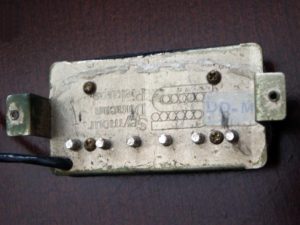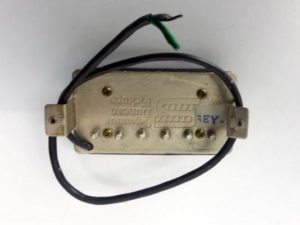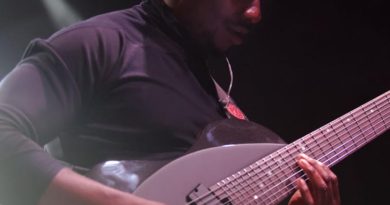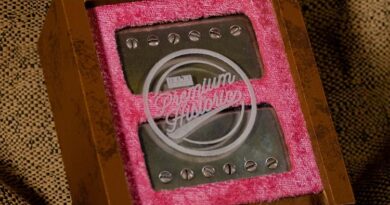Seymour Duncan Distortion Humbucker Pickup Set

How many of you have tried Seymour’s Distortion set? Did you know there’s a Distortion “set”? Yep, there’s also a neck model. Some do and some don’t. But that’s groovy. Let’s take a look.
Admittedly, I’ve tried the Distortion bridge and neck models previously. Just not at the same time. And… they were the relatively newer ones with the RoHS labels. I have to say that they didn’t seem to really do it for me. The neck was a little too wooly and the bridge was too scratchy for what I was expecting. “What is everyone raving about?”, I pondered.
More recently, I’m watching some videos of Fractal Audio’s Mark Day. Mark is laying out some demos of the Axe-Fx II and I’m wondering what he’s using in his Jackson PC-1. Mark tells me it’s the Distortion. Of course, Mark is a great player and the PC-1 is a great guitar. Still, that’s not how I remember the Distortion!
This gets me to wondering about some of the preferred experiences I’m having with some of the Duncan company pickups from many years ago. Who else went through my series on the different versions of Seymour’s JB humbucker? You guessed it. And off I go on the hunt for an older set of Distortions.
So, you ask, what is it about the older Duncans… the age of the magnets? Well, the Distortion uses ceramic magnets. Ceramic magnets, by comparison to Alnico magnets, are far more impervious to losing gauss – if at all. It’s my opinion that it goes to the era of the assembly. Just like my observations on the older JB models. The reasons are an article unto themselves. And wait until you see what I managed to find when it come to the Duncan Custom (more on that coming soon!).
Isn’t this about the point where people ask “Aren’t the JB and the Distortion the same wind?” A-ha! Trick question. There was a blink-and-you-miss-it window when the Distortion wind was definitely different. How? Nah, not saying. Maybe at another time. These days, the magnet makes them different. Beyond that, not so much. Don’t get me started on how it ties in to the Stag Mag, the Holdsworth, the Invader and the Dokkenbucker. HaHa!

What I found to use for this evaluation is very cool. Both are the older “stamp” sticker labels. The bridge is a DD-M and they neck is a SEY-M. The “M” means they are both from Martha Cameron. The DD, of course, is the Duncan Distortion. The SEY is from before the time that we know the neck model as SH-6N, when it was called the Seymourizer. Not to be confused with any pickups with the usually oval “Seymourized” sticker. “Seymourizer? “Seymourized? What choo talkin’ about, Phineas?!?” Hey man, ease up. Seymourized is from when people would send in a pickup for Seymour to rewind. It had been “Seymourized”. You dig?
Still, I think calling the Distortion neck the Seymourizer is cooler than calling the pair the Mayhem Set. Marketing the Distortion humbuckers as the Mayhem Set is like calling a nuclear bomb a Weapon Of Mass Destruction. An overthought way of telling you that it’s going to lay waste to whatever it hits. LOL!
I install the Distortion set into a double hum guitar and wire them up for independent series/split/parallel switching. And off we go. This is much more musical sounding than I remember the previous, more recently-made set. Both positions of these pickups have lows that are deep, yet controlled. No mud. The highs have a nice gritty bite. Even in the neck position, the Seymourizer is perfectly competent for lead and solo work that will cut through. The mids are what probably impressed me the most. A little throaty with a good roar and plenty of sonic girth.
Let’s just get this out of the way. Most of us are going to need to tweak the amp to get really nice cleans out of these humbuckers. Especially in full series mode. A versatile pre-amp like the Axe-Fx II XL+ made short work of dialing in a tone that makes the hard-hitting Distortion set shimmer like a tween vampire. Otherwise, go to split or parallel mode on the neck pickup for the best option for a clean tone.
As you should expect, rock music is where the Distortion set lives. Mark Day’s videos even display melodic rock. Of course, the Distortion also does metal just fine. Keith Merrow is no longer with the Duncan company. But when he was, he made a few interesting comparison/shootout videos. This one features the Distortion bridge at 1:08, and then again with guitar only at 14:34.
How about some specs:
Series – 16.502 K
Inductance – 7.144 H
Split N – 8.365 K
Split S – 8.173 K
Parllel – 4.132 K
Magnet – Thick Ceramic
Resonant Peak – 5.5KHz (advertised)
Series – 12.368 K
Inductance – 5.414 H
Split N – 6.133 K
Split S – 6.254 K
Parllel – 3.096 K
Magnet – Thick Ceramic
Resonant Peak – 6.5KHz (advertised)
Going from what I remember of the newer Distortion set when compared to this older set I tracked down, my preference is clear. Now, if you want something a little more clinical and more gritty, a newer set might be what the doctor ordered. The biggest drawback to the older set might be the longer mounting legs, which can always be swapped for shorter legs.
For reference, this Distortion set evaluation was conducted with my old trusty amp, as well a Fractal Axe-Fx II XL+. Cabs are a Peavey 6505 cab with 12″ Sheffields, and a Marshall 1960B cab with 12″ Celestion G12-65s.
Seymour Duncan Website | Facebook | Twitter | YouTube | Instagram




